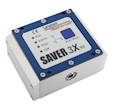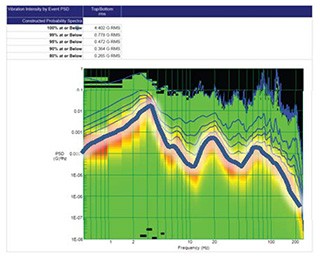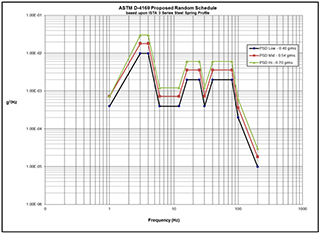
Lansmont is an integral part of the ASTM D4169 Task Group on Random Vibration.
This group has been working over the past couple of years on new random vibration profiles for Standard Test Practice D4169. Our real-world data expertise and technology is instrumental (hah, pun intended!) in developing the rationale and characteristics of the future random vibration profiles.

The current ASTM D4169 Truck Profiles are based on the Forest Products Lab Report FPL-22. That report was released in 1979. Data measurement technologies, not to mention the trucks themselves, have come a long way in 39 years. In more recent history, truck measurement studies—many of which are performed with Lansmont SAVERs—do not correlate well with ASTM D4169.
The PSD vibration data shown to the right reflects the general vibration spectral shape that is prevalent after measuring truck trailer responses from within a number of geographic regions. That spectral shape is different than the current D4169 truck profile.
Test specifications that were developed more recently such as ASTM D7386 and ISTA 3 Series tests use spectral shapes that correspond well with current measured truck data. We are recommending that ASTM updates the D4169 truck profiles so they’re similar to the spectral shapes already accepted and used in these other standards.

Transport vibration does not occur at constant intensity so it makes sense to vary the intensity during simulation of these conditions. Rather than using just one intensity for the entire test duration, we're proposing that the profile (spectral shape) be simulated at three different intensities which are representative of the 90th, 95th and 99th percentile levels observed during the Task Group's measurement efforts.
Each profile would be run for different time durations, however the total time would remain a 3-hour test. The recommended D4169 test profiles are shown to the left. A key step in the update process is of course verifying the improved effectiveness of the profiles through actual testing of packaged products. Some labs have already conducted test trials with excellent correlation between field and lab test results. ASTM plans to ballot the proposed truck profiles in 2015 and we will then start working on updates to the rail and air profiles.
Lansmont has devoted a lot of time to these ASTM efforts because it is important to continue advancing technology within the testing community.
- If you would be interested to learn more or participate in ASTM D4169, visit the ASTM D10 website.
- To speak with a Lansmont representative about these activities click here.
- For more information associated with Lansmont vibration test systems click here.